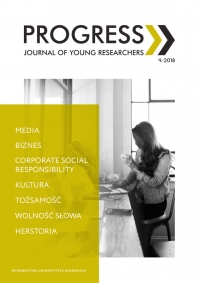Community myth as a basis for human’s interaction with web interfaces Summary
Keywords:
communication in Web 2.0, social media, community it the Internet, word in the Internet, image in the InternetAbstract
The history of media development can be interpreted as a process of externalizing cognitive processes and mediating contact between human and the world, and thus separating it from reality. Since the time of the invention (of writing), such categories as: absence, distance, solitude were embedded in the history of media development. New media (and new new media), founded on the idea of interactivity and participation, seem to go in the opposite direction. The community seem to be seen as the basis of user’s web 2.0 experience. The culture of sharing or exchanging gifts are just some of the ideas, which evidences belief in community in the new media. The concept of collectivity appears in this context as the key word for interpretation conditioned by the new media culture. Internet algorithms – PageRank, TrustRank, and EdgeRank – determine the content of the network, are based on the belief that their basis is not visibility for bots but collective authentication of content. This is the way to create mythical image of communication in Web 2.0, which seem to implicate the formation of cybercommunities, but on the other hand – proves that communication in Web 2.0 is an area of increasing alienation.
Downloads
References
Altman Ch., 1987, W stronę teorii gatunku filmowego, „Kino”, nr 6.
Bauman Z., 1996, Etyka ponowoczesna, Warszawa: Wydawnictwo Naukowe PWN.
Castells M., 2013, Sieci oburzenia i nadziei, Warszawa: Wydawnictwo Naukowe PWN.
De Kerckhove D., 1996, Powłoka kultury: odkrywanie nowej elektronicznej rzeczywistości, Warszawa: Mikom.
Derrida J., 1975, Pismo i telekomunikacja [w:] „Teksty: teoria literatury, krytyka, interpretacja”, nr 3 (21).
Filiciak M., 2013, Media wersja beta. Film i telewizja w czasach gier komputerowych i internetu, Gdańsk: Wydawnictwo Naukowe Katedra.
Flusser V., 1993/1994, Społeczeństwo alfanumeryczne, „Lettere Internationale”, nr 1.
Godzic W., 2002, Telewizja jako kultura, Kraków: Rabid.
Halavais A., 2012, Wyszukiwarki internetowe a społeczeństwo, Warszawa: Wydawnictwo Naukowe PWN.
Kirckpatrick D., 2011, Efekt facebooka, Warszawa: Wolters Kluwer Polska.
Kreft J., 2015, Za fasadą społeczności, Kraków: Wydawnictwo Uniwersytetu Jagiellońskiego.
Levinson P., 2008, Nowe nowe media, Kraków: WAM.
Levinson P., 2006, Miękkie ostrze czyli historia i przyszłość rewolucji informacyjnej, Warszawa: Muza.
Manovich L., 2006, Język nowych mediów, Warszawa: Łośgraf.
Marjankowska A., Drygalska E., 2016, Software studies – co to takiego?, „Znak”, nr 737, http://www.miesiecznik.znak.com.pl/software-studies-co-to-takiego.
Mauss M., 1973, Szkic o darze. Formy i podstawa wymiany w społeczeństwach archaicznych [w:] Socjologia i antropologia, Warszawa: PWN.
Ong W., 1992, Oralność i piśmienność. Słowo poddane technologii, Lublin: Wydawnictwo Katolickiego Uniwersytetu Lubelskiego.
Ricouer R., 2003, Mowa i pismo [w:] Antropologia słowa zagadnienia i wybór tekstów, red. G. Godlewski, A. Mencwel, R. Sulima, Warszawa: Wydawnictwo Uniwersytetu Warszawskiego.
Szpunar M., 2010, Nowe media a paradygmat kultury uczestnictwa [w:] M. Graszewicz i J. Jastrzębski (red.), Teorie komunikacji i mediów 2, Wrocław: Wrocławskie Wydawnictwo Oświatowe.
Wilk E., 2000, Nawigacja słowa. Strategie werbalne w przekazach audiowizualnych, Kraków: Rabid.
Downloads
Published
How to Cite
Issue
Section
License
Copyright (c) 2018 Author(s)

This work is licensed under a Creative Commons Attribution 4.0 International License.

 Academic Scientific Journals
Academic Scientific Journals




